David Nickle's Blog
August 14, 2021
In the orbit of Lorna Toolis – 1952-2021
 Lorna Toolis, July 2021, in Temagami, Ontario – Photography by Do-Ming Lum/Tiger Mountain Creative Services
Lorna Toolis, July 2021, in Temagami, Ontario – Photography by Do-Ming Lum/Tiger Mountain Creative ServicesDoes the Moon understand itself to be orbiting the Earth? Leaving aside the point that it almost certainly hasn’t the wit to even wonder, I can imagine that it would not. It would have no idea how much its course in the universe depends on the gravitational presence of its companion.
But take that companion away … well, the moon would have to be some kind of non-sentient ball of rock and dust and ice, not to suddenly realize how lucky it had been all those millennia.
In that spirit, I am coming to realize my good luck, to have lived so many years in orbit of Lorna Toolis. She died on Wednesday afternoon (Aug. 11).
Lorna was the long-serving collection head of the Merril Collection of Science Fiction, Speculation and Fantasy – a world-class collection of science fiction and fantasy materials at the Toronto Public Library. The birth of that collection preceded Lorna, but by only a few years; when she started, it was still known as the Spaced Out Library, seeded by a donation of science fiction writer and editor Judith Merril’s personal collection of books in 1970.
In the late 1980s when I first met Lorna, the Spaced Out Library was on the second floor of the Boys and Girls House at Beverly and College Streets. Not climate-controlled. Not accessible. As ad-hoc a library as its name might suggest.
I’d come in as a journalist, ostensibly working with another writer on an article about the Canadian science fiction community for a local alternative paper – but really, dipping my toe into a world that I very much wanted to enter.
Lorna helped me do both. First, she gave me a who’s-who rundown of sources I might speak to, suggested I hit Ad Astra, the local science fiction convention to find those sources in one place.
Those sources included Judith Merril herself, who after a very professional interview, told me very candidly, about a writer’s workshop that might be looking for members – and introduced me to one of the founding members, Michael Skeet. Lorna’s husband.
I and my collaborator Shlomo Schwartzberg wrote our article, and I think it was pretty good. After a bit of to-and-fro-ing, I took my seat at the Cecil Street Community Centre, where the workshop met in those days, and became a not-quite-founding-member of the Cecil Street Irregulars workshop. I learned to write. I started to publish. I found a community, like I’d never had before, in that corner of the local SF scene. In the course of all that, I entered orbit.
Lorna’s orbit.
I’ve written elsewhere that Lorna was one of my dearest friends; that I would not be who I am without her.
Lorna Toolis, former head librarian at the Merril Collection of Science Fiction, Speculation and Fantasy in Toronto, has died. She was an important figure in Canadian SF/F, and more importantly, one of my dearest friends. I would not be who I am without her.
— David Nickle (@bydavidnickle) August 12, 2021
I’ll say here that I’m not unique; Lorna had many moons circling her when we met, and many more still by the time that she died. Part of that may have been due to her role as collection head of the library that she helped push to rename the Merril Collection, and move to the more suitable Lillian H. Smith branch on College. The library is a comprehensive collection of sf material and an invaluable research institution. Lorna made it into a hub, for a community of readers and creators not only in Toronto, but across the country and around the world.
If Lorna had only applied her dedication, hard work and passion for the genre, as considerable as all those qualities were, I don’t know that she would have been able to pull it off. It was Lorna’s not-so-secret weapon – a combination of kindness, generosity and when required, absolute steel – that brought it all together.
As she helped me enter the world of SF and F in very particular ways, so I think she did with almost everyone else who came in.
So the SF community is lucky to have had Lorna Toolis for a singularity.
I am luckier than that.
From those early days until just a few days ago, I saw Lorna and Michael almost every week, and sometimes more often than that. We were neighbours in Toronto’s east end – part of a small community of friends who early on made a decision never to stray too far from one another. We eat together, celebrate together, gather every few weeks to play pencil-and-paper role-playing games (Lorna was a master at refereeing Call of Cthulhu and after her retirement went at it with a gleeful vengeance; there is probably another blog post memorializing her meticulously-researched home-brew scenarios and campaigns).
And we grieve together.
When Lorna died, she was in the midst of an against-the-odds battle with cancer. It was a battle similar to ones she’d witnessed before, fought and lost by too many other dear friends. As she faced it herself, she did so with courage and good humour, to an extent that should not have surprised anyone who knew her, but struck me nevertheless.
I miss Lorna terribly. But just a few days outside her orbit now, I am so grateful to have known her, and to have been shaped by her kindness and example. Any moon should be so lucky.
The post In the orbit of Lorna Toolis – 1952-2021 appeared first on David Nickle.
December 30, 2020
The Last Word on the Plague Year 2020
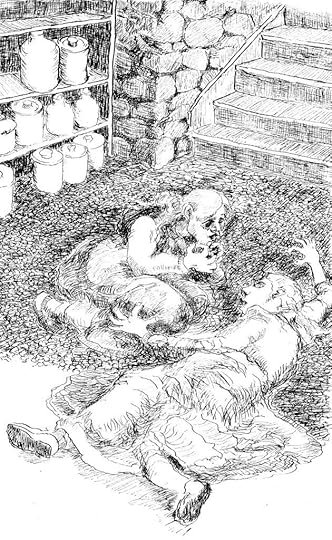 Illustration for Eutopia: A Novel of Terrible Optimism” by Lawrence Nickle
Illustration for Eutopia: A Novel of Terrible Optimism” by Lawrence NickleAt the ends of most of the years I’ve lived through (and there have been more than a few), the little miseries and disappointments of the previous 365 days were generally ones unique to me, so when I looked back on a year, I’d keep those to myself, or tell a few close friends, or maybe just write them down and set them afire. They were nobody’s business.
2020 was different of course. In at least the broad strokes, we have been united in our dismay; there’s no secret to them. You could say that the apocalyptic COVID-19 pandemic has given the world a common language of suffering and dread and it gives us all a small window into one another’s souls.
Not that all suffering is equal. Even in these times, it is far from that. But dread? Whatever else is going on in our lives, the same beast is at all our doors. For too many of us, it’s stepped inside.
It hasn’t here. Madeline and I have been able to isolate, do our work at home, keep in touch with the outside world through Zoom, Google, Face Time and the phone – and the odd distanced, outdoor visit with mask and sanitizer close at hand. We’ve been absurdly healthy; one side effect of all this masking and isolating from COVID-19 is also isolating and masking from the cold and flu. And of course we spent the year COVID-19-free, as have the people around us.
Still. It’s been a slow year for new writing. Not entirely a stagnant one – I’ve got some incremental work to show for 2020 – and the year’s finishing with a new project soon to be announced that’s going quite nicely – but 2021 has some catching up to do.
There have been no conventions or other literary events. I would have been at at least one – the International Conference for the Fantastic in the Arts, which was to take place in Florida, back in March. I’d gone so far as to book a hotel room but had, happily as it turned out, put off booking a flight, by the time it became clear that lockdown was if not imminent then at least advisable. A few days after I cancelled with ICFA, the organizers sensibly cancelled the whole thing.
Like a lot of people, I find myself wondering if there’s ever going to be another destination-convention in the genre again. Maybe… probably. But it does seem a long way off.
Of course, the world has a way of surprising you. In late 2019, I was faced with the prospect of all my books falling out of print, possibly indefinitely. By this time this year, I was pretty sure that wasn’t going to be the case. Open Road Integrated Media got in touch with my agent Ron Eckel in late November, to talk about the possibility of picking up my backlist that had been published with ChiZine, and putting them all out as e-Books and trade paperbacks.
By May of 2020, we’d finished all that talk, and I was able to announce the republications of six books. Eutopia and Volk, which together make up my Book of the Juke series, came out in August, and the rest of them – Rasputin’s Bastards, The ‘Geisters, Monstrous Affections and Knife Fight and Other Struggles – appeared just over a month ago from the time of this writing.
The new covers and designs… well, I’m very happy with them.


I built a new website too – or rather, I hooked up with Jeremy Tolbert and his company Clockpunk Studios, to build this website. It replaces my dozen-or-so year-old website that I’d cobbled together somehow with Blogger and the no-longer-supported Google Pages service. The site’s got the same ‘name’ as the old one – the Devil’s Exercise Yard – but a new and more succinct domain: davidnickle.ca. And otherwise it is as smooth and beautiful and elegant as I could have hoped for. As an added bonus in a year in which I haven’t been able to meet many people at all, I got to meet Jeremy, who is good people.
I’m grateful for that.
In fact, as I write this I realize that I am grateful for a lot of things this past year – far more grateful than regretful. These are dangerous times, it’s true, and the beast is at the door. Yet so far, Madeline and I have been able to both remain safe and happy, and in the main hopeful that we can pass through this and move on to something that is better than today, if not perhaps exactly the same as it was before.
The post The Last Word on the Plague Year 2020 appeared first on David Nickle.
November 23, 2020
Launch Day for the Library
Strictly speaking, it’s relaunch day. But however you cut it, today is the day.
Just about a year after my former publisher ChiZine Publications returned the rights of my backlist, here they are: four novels and two short story collections, available in ebook and (mostly) print, from my new publisher Open Road Integrated Media.
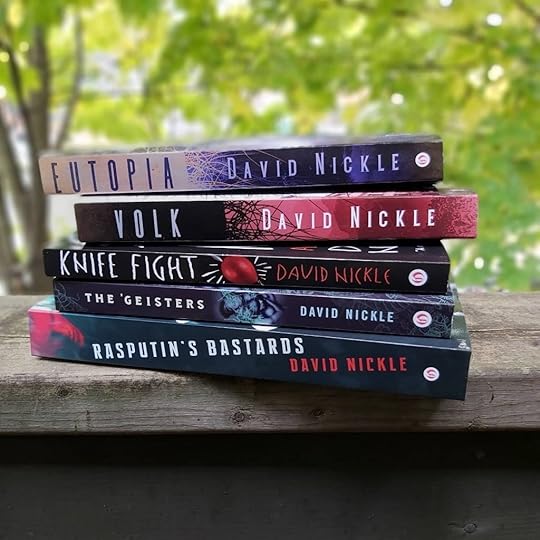
These are the print copies, that arrived in the mail back when there were still leaves on the trees outside our home in the Stable. Missing – temporarily – from this stack of hard copies is my debut short story collection, Monstrous Affections, which we held back a bit while the old ChiZine stock of the 2019 rerelease are still in some bookstores. But like the rest, it’s available in eBook form from Open Road Integrated Media.

I wrote a bit about each of the books when we announced the pre-ordering (you can read my thoughts on the four that are dropping, Monstrous Affections, Rasputin’s Bastards, The ‘Geisters, and Knife Fight and Other Struggles, here; and the Book of the Juke series – Eutopia: A Novel of Terrible Optimism and Volk: A Novel of Radiant Abomination that came out earlier in August, here), but in general: they span the bulk of my published work as an author.


For the first time in a year, all of these are back available. You can check them all out here at The Devil’s Exercise Yard.
The post Launch Day for the Library appeared first on David Nickle.
September 13, 2020
Considering the Sadakovirus: A rewatch of Ringu in the Plague Year 2020
In fall of 2002, I joined a big crowd of moviegoers in the old Varsity Cinema in downtown Toronto, to watch a horror movie about home video that was outmoded even then.
Gore Verbinski’s American remake of the 1998 Japanese horror film Ringu is about a cursed VHS videotape, made by a psychically powerful and profoundly angry girl, Sadako Yamamura. If you watch it all the way through – and it’s not long, so once you start it you’ll probably finish it – you get a mumbly phone call, which will start a seven day count-down to your really awful demise at the clawed hands of a Sadako’s vengeful spirit.
Looked at another way – and this is a bit of a spoiler, the first of many – you’ve got seven days to find it within yourself to make a copy of that videotape, and pass it on to someone else. If you do this, the spirit passes you by and the whole thing becomes the next person’s problem.
Those were the rules.
Here in the late summer of 2020, nine months in to a worldwide COVID-19 pandemic, there are different rules. Among them: If you know what’s good for you, no big crowds, and no movie theatres. So my wife and I spent a couple of movie-nights at home, rewatching not Verbinski’s Seattle-set The Ring, but Hideo Nakata’s 1998 Japan-set original and its continuation-sequel, Ringu 2.
We watched them through the 2020 version of the VHS format: an online streaming service, Shudder TV in this case, that distributed its grindhouse-and-horror catalogue as far as its subscriber-list would take it. And in these pandemic times, it got us thinking and talking about the central metaphor of the story – the wilful and amoral spread contageon to survive-if-not-break a mortal curse – in a bit more immediate way than we had before.
The cursed videotape in Ringu is an obvious stand-in for a disease vector. Koji Suzuki’s original 1991 novel on which the films were based made it even more literal. His Sadakovirus combined the girl’s fantastical psychic powers with the mundane horror of smallpox and her own deep-seated anger to propagate itself.
But to use the parlance of these pandemic-literate times, the Sadakovirus is one with a relatively low reproduction factor. That is to say, it would only hit a factor of one (one viewer sends one copy to one recipient) in a world where everyone knew what they needed to do to survive after the seven-day countdown, and everyone had access to two VCRs to do that thing. And in that perfect world, symptoms – i.e. Sadako showing up with her uncut bangs and and deadly touch – would only manifest at the end, when everyone had seen her short film. Then the factor would be closer to ∞.
In even a hypothetical reality, most people who watched the tape – even those teenagers who’d heard the first part of the urban legend – would simply suffer six sleepless nights and seven twitchy days, only to be blindsided by a terrifying and terrible death. That group of people would include the ignorant, and also the altruistic. Because of course the right thing to do after watching that video would be to suck it up, take six days to settle affairs, burn the tape then wait for the monster on the seventh, in the knowledge that the reproduction factor will henceforth stay at a tidy zero.
As described the book and the films, the Sadakovirus is spread by our enlightened selfishness. The vector has a moral component, and it is the good who die young from it. The clever, wicked ones prevail.
For the past year, we’ve been wrestling with the moral componenet of the Coronavirus’ spread too – although it might be better to say that where the Sadokavirus relies on enlightened selfishness to move it through its hosts, the Coronavirus does its best work in unenlightened selfishness. Wilfully unenlightened selfishness.
You don’t want to wear a stuffy old mask? It’s so nice out, the kids are bored and you want to go to the beach for the day? You’re lonely and you want to hit a bar to meet some people, maybe get laid? Not a problem. Facebook and Twitter put a pair of VHS machines in the hands of everybody with a smart-phone to make copies of the misinformation of their choice, to justify all of those indulgences.
Of course, the individual moral component of COVID-19 is but one piece of the vector-puzzle – there is a much larger societal moral component .
Front-line workers and low-income people have no choice but to expose themselves and their family to the disease, in order they might eat and pay rent – and the vulnerable elderly and disabled in long-term care rely on the willingness of government to part with the money and resources to fund their survival.
Even when people in this situation are informed, they lack the resources… that pair of conjoined VCRs if you will… to make a choice one way or another about their survival. Sadakovirus visits at her pleasure and she is subject only to the altruism of those in greater power, who may sacrifice wealth but not life in its exercise.
Over the past few years, Ringu and the Japanese horror cinema that it accompanied, have fallen somewhat out of fashion. Such is the way of it with horror-movie trends – the popular tropes become too familiar and the once-apt subtext, less relevant.
One of those tropes was a sense of grand futility. The malevolent supernatural incursions at its core were not subject to easy banishment, and to survive them, one had to learn to live by their rules. The truth, in other words, does not free us but constrains us, for our own protection.
The may not be as fashionable in 2020 as it was a couple of decades ago. But the subtext seems to me to be chillingly relevant.
The post Considering the Sadakovirus: A rewatch of Ringu in the Plague Year 2020 appeared first on David Nickle.
September 10, 2020
Here at last! The new covers for two novels and two collections

Finally it can be revealed: four new covers for four back-in-print books of mine.
Specifically, my novels Rasputin’s Bastards, The ‘Geisters and my short-story collections Monstrous Affections are back in print. They’ve got new cover,s designed and applied by their new publisher, Open Road Integrated Media. I’ve been sitting on these images for awhile, waiting for them to come up for pre-order. Now it is very nice indeed to be able to show them off, and express some gratitude.
Each of these books (and Eutopia and Volk) were originally published with ChiZine Publications, their covers beautifully and strikingly designed by Erik Mohr. One of them, the cover to Monstrous Affections, was so striking as to become iconic and a part of a brand for both ChiZine, and for me. It was a high bar.
Each of these covers meet it. So thanks to the art department at Open Road for packaging these up so very nicely.
Eutopia and Volk (the two volumes of my Book of the Juke series), Open Road repackaged in this gorgeous matching set:

And here’s a run-down on the rest of them.
Rasputin’s Bastards
 Rasputin’s Bastards cover, Open Road Integrated Media edition
Rasputin’s Bastards cover, Open Road Integrated Media editionWhen people ask me for the elevator pitch for Rasputin’s Bastards, I usually respond with “It’s like Gravity’s Rainbow, without the literary merit.” It is probably my weirdest and most experimental novel – and in some ways also my most conventional. At least that’s how it started out, as a post-Cold-War thriller about psychic Russian spies making their way in the post-Cold-War world. For awhile – particularly in the early 21st-century, post-9/11 years – ex-Soviet spies covertly interfering in every aspect of North American life and even thought might have seemed dated. But maybe things have come around in the last few years.
The ‘Geisters
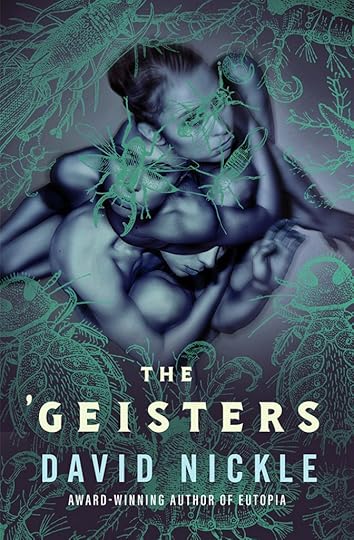 The ‘Geisters cover, Open Road Integrated Media edition
The ‘Geisters cover, Open Road Integrated Media editionThe ‘Geisters is my ode to Ira Levin, Shirley Jackson and the cult of the jump scare. I might pitch it as Rule 39 meets Poltergeist. Its opening line is “Was it terror, or was it love?”, and it goes from there.
Knife Fight and Other Struggles
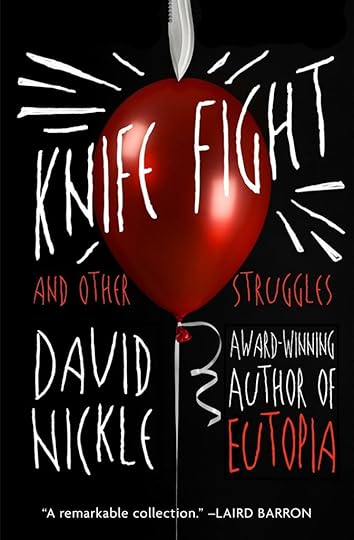 Knife Fight and Other Struggles cover, Open Road Integrated Media edition
Knife Fight and Other Struggles cover, Open Road Integrated Media editionKnife Fight and Other Struggles is my second story collection, and it’s eclectic. There are science fiction stories, fantasy stories a lot of horror stories – and the title story, which was drawn in very, ahem, non-specific ways from my years covering the administration of Toronto Mayor Rob Ford.
Monstrous Affections
 Monstrous Affections cover, Open Road Integrated Media edition
Monstrous Affections cover, Open Road Integrated Media editionThis is a new edition of my first story collection – the author-illustrated version of Monstrous Affections. The book originally came out in 2009, with a cover by Erik Mohr that was so good and awful and creepy it became iconic. This cover echoes that one – it too is the not-quite-right pale face of a man, with eyes shut. The original cover illustrated the first story in the collection, “The Sloan Men,” which I’ve also published here at the Devil’s Exercise Yard. This edition also features a tag-team foreword/afterword by Laird Barron and John Langan, and illustrations that I did myself.
All of these are available for pre-order now, for an official publication date of November 24, 2020.
The post Here at last! The new covers for two novels and two collections appeared first on David Nickle.
August 17, 2020
The Eutopia/Volk Socially-distanced, Online Relaunch / Book-Signing Event, 2020
Back in the before-days, I always did enjoy me a book launch – particularly if it was one of my own.but also book launches of dear friends and colleagues. We’d get together at a bar or a bookstore, or a bar and a bookstore, or sometimes a public library – and there’d be a stack of books and something to eat or drink… and from the author, a reading of some mercifully brief passage with a bit of action and a clever metaphor or two for the cheap seats.
Then everyone would line up at a table with all of the books on it and buy one, then line up again where the author was sitting, and they would sign them.
When it was me at the signing table, I always tried to do a little something extra. A nice note, and a doodle.
In my first book the Claus Effect (co-written with Karl Schroeder) I would doodle a little drawing of a deranged Santa Claus next to “Merry Christmas You Ungrateful Bastards,” because that was a line from the book and Santa Claus figured prominently. With Monstrous Affections, a story collection, I’d draw a cyclops coming in for a hug – because in this book there lurks a very handsy Polyphemus. Rasputin’s Bastards, it was a Russian doll with a gun and a scowl that was ,like the book’s title, entirely figurative.
When Eutopia: A Novel of Terrible Optimism came out, I did this:
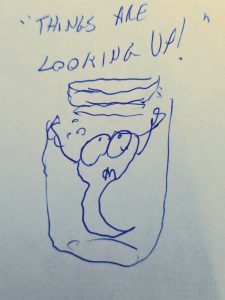 Original Eutopia Autograph Courtesy Steve Bevan
Original Eutopia Autograph Courtesy Steve BevanAnd when the sequel Volk: A Novel of Radiant Abomination came out, this is what I did:
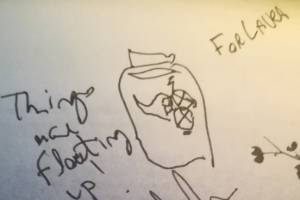 Original Volk Autograph courtesy @stcaffeinated
Original Volk Autograph courtesy @stcaffeinated
Well, it’s 2020 and as much as I’d like to, with the pandemic it is very difficult and potentially deadly to do another autographing session in person. But there are new books out: dead-tree editions of Eutopia: A Novel of Terrible Optimism and Volk: A Novel of Radiant Abomination, out from Open Road Media. And while the books aren’t brand new, the packages are, and I would like to sign some of them with a drawing, just like I always did.
It might seem hopeless here in the Plague Year, but for the Internet – and the endless gulf of time before us.
So here’s the deal.*
The Eutopia and Volk Relaunch Book-Signing Party starts now. I will be signing books until … well, until it gets unfeasible, in this way. If you buy the book, just post a picture of it on Twitter and tag me (@bydavidnickle) in the post, or do the same thing on Instagram (david_nickle), or Facebook (davidnickleauthor). And I will reply promptly, with a signature sheet that looks a bit like this one.
 A sample signature sheet, made out to my dear friend August Derleth
A sample signature sheet, made out to my dear friend August Derleth The doodle will be the same little Fiji-Mermaid-type baby Juke in a jar. But yours will not be made out to August Derleth with a stupid dad joke play on his name. Yours will be made out to you, with a stupid dad joke play on your name. Or with whatever else strikes my fancy, because you never can tell with me.
It is properly sized to be printed out and attached inside the front of either Eutopia or Volk (or both!). Alas, I cannot figure out how to get you any booze or food at this launch, and I have yet to post a reading (although that may well come!), but we take what we can get here in the Plague Year of 2020.
Be well!
* You can find out ways to purchase hard copies of Eutopia and Volk at their book pages here at the Devil’s Exercise Yard.
The post The Eutopia/Volk Socially-distanced, Online Relaunch / Book-Signing Event, 2020 appeared first on David Nickle.
August 9, 2020
The Cave Germ Revisited, in the Time of COVID-19
Jason Thistledown’s mama was tall and beautiful and strong; stronger of arm than many a man and more powerful of spirit than any two. Yet in the end it was not a man nor two nor even a gang of them, but a damn germ that killed her.
-From Eutopia: A Novel of Terrible Optimism, Chapter Two: A Damn Germ
Usually when I talk about my novel Eutopia: A Novel of Terrible Optimism, I talk about the pseudoscience of eugenics, and H.P. Lovecraft, and racism, and parasitism – because all of those things are front and centre in the book, and for much of its time in print they’ve been front and centre in the current discourse too.
 Illustration for Eutopia: A Novel of Terrible Optimism” by Lawrence Nickle
Illustration for Eutopia: A Novel of Terrible Optimism” by Lawrence NickleThere was not as much impetus to talk about the other element in the book – an element that arguably drives events to their conclusion as much as any of those other themes and elements, or for that matter, all of them combined.
The Cave Germ.
Introduced in Chapter Two – A Damn Germ, the germ hits the isolated Montana town of Cracked Wheel hard and fast. In a matter of days, it kills the mother of Jason Thistledown – one of the book’s two main characters – and does the same to almost everyone else in the little town. Jason’s status as a newly-minted orphan drives his decisions and development – and of course his fortunes – as the story moves him to far-off Eliada in northern Idaho. And although the isolated nature of Cracked Wheel limits its natural spread, the Cave Germ does get around.
In the novel, I don’t explain too much about what the Cave Germ might in fact be. The story takes place in 1911, when virology was still a relatively new science and viruses were known mainly by their effects. In terms of those effects, I treated the Cave Germ as a super-charged airborne Ebola-like strain with a near hundred-percent mortality rate, and a ferociously quick incubation period. It is as much a weapon as it is an affliction.
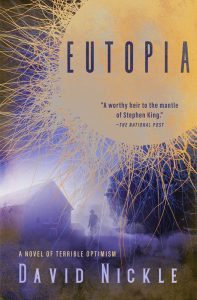 Eutopia: A Novel of Terrible Optimism
Eutopia: A Novel of Terrible OptimismWhen Eutopia was first released, in 2011, it was just a few years after that other pandemic, the 2003 SARS outbreak, had hit my hometown of Toronto. I was covering that outbreak as a journalist, and although the threat of it was well-enough contained, its potential caught enough in my imagination that this far more deadly construction crept into the writing.
Eutopia’s back in print now, when my hometown and the world is hit by another SARS-type coronavirus – worse than that first one, but not quite as bad as the neutron-bomb of an outbreak that the invented Cave Germ virus would have caused.
But I have to say, had I sent the Cave Germ into the wider world than the events of Eutopia allowed, I’m not sure I would have been able to imagine the impact that this less deadly COVID-19 virus has had.
I might have imagined some of the denial and obstinance that’s emerged in the anti-masking movement – there was in fact some of that during the 1918 mis-named Spanish Flu pandemic – but I wouldn’t have guessed at the vehemence of it. I certainly wouldn’t have imagined a U.S. president leading it by example.
I did to an extent imagine the effects of isolation for those who were quarantining – Jason in that chapter spends weeks alone in his family cabin after having stowed his mother’s corpse, and he’s left damaged and vulnerable at it. But on a mass scale, as is happening to an entire planet?
In the first place, I wouldn’t have predicted that governments would have the wherewithal to order lockdowns on the scale that they had; I would have thought that self-isolation would be practised by the survivors and most people would be left to their own choices (as is in fact happening in much of the United States).
Earlier in the pandemic, I interviewed former gaming entrepreneur and restaurateur Jason Kapalka about his Storm Crow Manor chain of nerd-bars and how they were managing the shut-down – and what the future held in a world where everyone must turn away from one another.
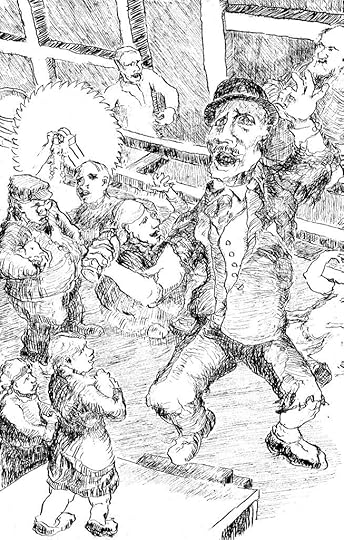 Illustration for Eutopia: A Novel of Terrible Optimism by Lawrence Nickle
Illustration for Eutopia: A Novel of Terrible Optimism by Lawrence Nickle“The apocalypse we’ve got here is far less dramatic in terms of the Mad Max apocalypses. This is more of a glum apocalypse — everybody sitting inside playing Animal Crossing and just getting takeout from McDonald’s and Pizza Hut,” was his answer.
That was months ago. And from that prediction of a “glum apocalypse,” I wouldn’t have predicted the premature attempt to return to normal – to beat that glumness back – with first bars and theatres, and a few weeks later, schools reopening in my hometown, when COVID-19 is still extant and there is neither vaccine nor treatment for it. I wouldn’t have understood our capacity to shrug off potential calamity, to deny the necessity of a glum apocalypse, in this uncertainty.
I wouldn’t have understood exactly how thoroughly uncertainty about what happens could cast its shadow over everything. I can’t remember a time when the near future was so very opaque.
As Eutopia comes out in its new Open Road Media edition, I am, honestly, struggling with new work because of the ever-changing transformation of our lives that COVID-19 is bringing about.
I think every writer of contemporary fiction is facing this question: what will the new world look like when the stories we write are published in a year or two? Will there be any commonality with the world we imagine as we sit down to write, and the shifting world in which our audience is sitting down to read?
We can guess as well as anyone. Likely that audience will have survived a second wave of the coronavirus. Hopefully, they will be vaccinated and healthy, or recovering after a proper round of proven treatments, and not still hiding out in quarantine or dangerously ignoring public health advice.
It’s likely that a great many will have less disposable income than they do now, as the concurrent economic collapse continues, and many will no longer have enough money to cover what we now think of as the basics of life without help from government that may or may not be there.
But that’s just my guess – and really, what do I know? Making it all up, as I did with the Cave Germ, I’m bound to get a lot of things wrong.
The post The Cave Germ Revisited, in the Time of COVID-19 appeared first on David Nickle.
August 3, 2020
The Book of the Juke – Eutopia and Volk
 When Eutopia: A Novel of Terrible Optimism launched in 2011, I started signing copies with a somewhat quicker version of this doodle. Given that the new edition launching today is e-book only for now – and even if there were physical copies, a lineup for autographs would be unhygienic in these physically-distanced times – I thought I could take a bit more time on just this one.
When Eutopia: A Novel of Terrible Optimism launched in 2011, I started signing copies with a somewhat quicker version of this doodle. Given that the new edition launching today is e-book only for now – and even if there were physical copies, a lineup for autographs would be unhygienic in these physically-distanced times – I thought I could take a bit more time on just this one.
It was more than a decade ago now that I started work on what would become my first solo novel: Eutopia: A Novel of Terrible Optimism. Its working title was Mister Juke – named for the monster at the heart of it, a shape-shifting, parasitic creature that shapes the brain structures of communities of faith to better feed itself, in the way that toxiplasma gondii shapes the brains of rats and mice, to better feed cats.
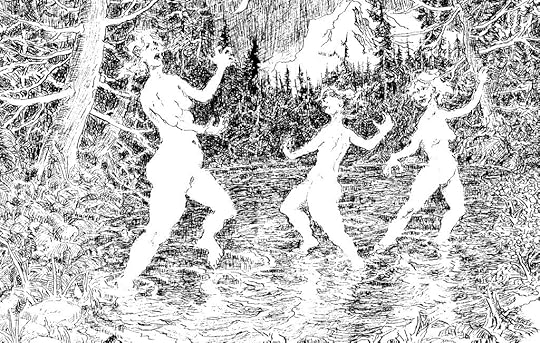 Illustration of the Feeger sisters, dancing in thrall of the Juke, for Eutopia: A Novel of Terrible Optimism by Lawrence Nickle
Illustration of the Feeger sisters, dancing in thrall of the Juke, for Eutopia: A Novel of Terrible Optimism by Lawrence NickleIt was also a novel of the early American eugenics movement and the human monsters who propagated that, and when it was ready to publish the title shifted to Eutopia. Fantasy author Michael Skeet was the one to suggest it as a clever mashup of Utopia and Eugenics, to reflect those human monsters, and the terrible optimism that drove them to sterilize and segregate people they mistook for their inferiors, and ultimately provided ideological cover for the genocidal atrocities visited on the world most famously – but far from exclusively – by Adolph Hitler’s Nazis.
I didn’t plan a sequel in the writing, but after Eutopia was published through ChiZine Publications in 2011, I started thinking about it, and in 2017, published a sequel: Volk: A Novel of Radiant Abomination. As the title suggests,Volk deals more directly with those Nazis, and also took a deeper look at the Juke, what made it tick, and the long-game implications of its existence. Volk takes the action from a small utopian logging town in northern Idaho in 1911, to Bavaria and France in 1931. Together, they form the longest single narrative I’ve written: The Book of the Juke.
 Illustration of the town of Eliada, for Eutopia: A Novel of Terrible Optimism, by Lawrence Nickle
Illustration of the town of Eliada, for Eutopia: A Novel of Terrible Optimism, by Lawrence NickleBoth volumes of The Book of the Juke are available now in e-book editions from Open Road Integrated Media, with beautiful new covers. It’s a re-launch rather than a launch, so neither books have the benefit of the kind of reviews and blog posts that a brand new novel would on launch-day.
But the two did receive some attention when they originally came out. Reviews and interviews and blog posts. I’ve gathered some links to those reviews and some interviews such as still persist online – as well as a sample from the start of Volk, on The Devil’s Exercise Yard (aka davidnickle.ca).
But the two did receive some attention when they originally came out. Reviews and interviews and blog posts. I’ve gathered some links to those reviews and some interviews such as still persist online – as well as a sample from the start of Volk, on The Devil’s Exercise Yard (aka davidnickle.ca). If any of this persuades you to pick up a copy, go ahead and click on the cover images, or the links below.
Eutopia: A Novel of Terrible Optimism
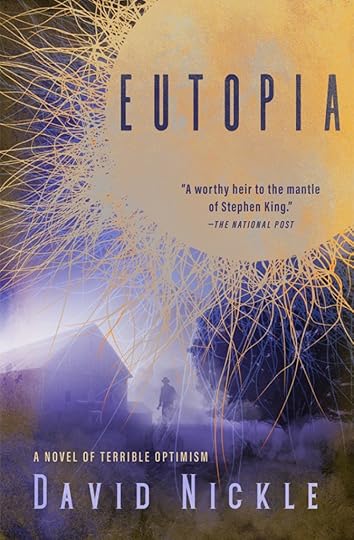
Publishers WeeklyBoingboing (Cory Doctorow)The National Post (Alex Good)AEscifi.caSFsignal.com (Jessica Strider)Jamesdavisnicoll.comInterview on Curiosity Killed the Bookworm
Volk: A Novel of Radiant Abomination

Publishers Weekly (starred review)The Toronto Star (Alex Good)Boingboing.net (Cory Doctorow)Cemetery Dance (Chris Hallock)Metaphysicalcircus.com (Paul St. John Macintosh)Hellnotes (Gordon B. White)Interview with Gordon B. White on Hellnotes‘Orlok’: Sample prologue of Volk: A Novel of Radiant Abomination
So that’s it: a proper – and appropriately hygienic – relaunch! To purchase from various vendors, you can click on the images, or these links.
To Purchase Eutopia: A Novel of Terrible Optimism
To Purchase Volk: A Novel of Radiant Abomination
The post The Book of the Juke – Eutopia and Volk appeared first on David Nickle.
July 17, 2020
This is not the Yard you're looking for
davidnickle.ca
and you'll find everything that's here now, plus some new stuff. New books. New stories. Some drawings maybe.
There won't be any more new stuff here. So you may as well head over now.
See you there.
Eutopia and Volk are Live… and The Yard has a new home!

This is a big moment in the life of my old blog The Devil’s Exercise, and also a couple of my old books: Eutopia: A Novel of Terrible Optimism and Volk: A Novel of Radiant Abomination.
To start with, the blog. For more than a decade, the Devil’s Exercise Yard and I have been doing what I like to think is an admirable job of half-assery, operating on Google’s Blogger, with an accompanying website on Google Pages. There was tons of content, some semi-regular updates and a much more flattering author photo. But even then at the dawn of the 21st century, it had all the graphic charm and functionality of a photocopied fax to a pharmacy.
Well no more. This year, with the help of Jeremy Tolbert and Clockpunk Studios, I’m wrapping up The Devil’s Exercise Yard at Google and resurrecting the Devil’s Exercise Yard on a tricked-out WordPress platform, at davidnickle.ca. The site’s adorned with artwork by my late father Lawrence Nickle, and some more by me, and some but not all of the content from the old site.
It is also going to be home to my catalogue (hopefully growing) of books and stories… which leads me into the next part of this inaugural blog post: Eutopia and Volk.
In 2019, I obtained the rights to my backlist of novels and story collections from ChiZine Publications, and in short order hooked them back up with a new outfit, Open Road Integrated Media. Open Road has been around for not quite as long as The Devil’s Exercise Yard, but the company has been far more innovative (not, admittedly, a very high bar to clear, but they have been extremely innovative). The company focusses primarily on e-book marketing, and built its list initially by gathering back-list titles, many of which had been sold to their original publishers before electronic rights were a commodity. It is amazing the calibre of works a publisher can accumulate, offering authors and their estates more-than-reasonable royalty rates and the promise to market their back-list the way other publishers market new titles.
So if you want to read e-books of Fritz Leiber or Poul Anderson or Octavia Butler, Pat Conroy or Harlan Ellison or Graham Masterton – Open Road’s catalogue is where you’re going to go.
Over the next few months, almost all of my books will be in that catalogue – and we’re getting a start with Eutopia and Volk, my debut horror novel and my latest respectively. The two books make up the Book of the Juke, a long horror story that starts at the birth of the American eugenics movement in 1911 America, and finishes with the rise of National Socialism in 1931 Germany.
 The new cover of the Open Road Integrated Media edition of Eutopia: A Novel of Terrible Optimism
The new cover of the Open Road Integrated Media edition of Eutopia: A Novel of Terrible OptimismBoth books are up for pre-order at all the usual places, with an official release date of Aug. 4. They are the same books, but with new and to my eye extraordinary cover art, and just a bit of a polish from sf-publishing veteran Betsy Mitchell, who’s Open Road’s Strategic Advisor for Science Fiction and Fantasy and the editor overseeing my books.
 The new cover for the Open Road Integrated Media edition of Volk: A Novel of Radiant Abomination
The new cover for the Open Road Integrated Media edition of Volk: A Novel of Radiant AbominationMore will be coming soon. My novels The ‘Geisters and Rasputin’s Bastards, and my short story collections Monstrous Affections and Knife Fight and Other Struggles are due out in the fall. For now, they’re all e-books, with the possibility of being available in print on demand down the road.
I’d like to see them in print. We’ve finalized all the covers, and you have to trust me when I say they’re each every bit as stunning as the work that Open Road’s art department did for Volk and Eutopia. They’d all look good on someone’s shelf.
But for now, they’ll look very good on the screen of a tablet. And I’m very happy to see them coming available again at all, after what’s happily turned out to be a relatively short time in the wilderness.
The post Eutopia and Volk are Live… and The Yard has a new home! appeared first on David Nickle.



